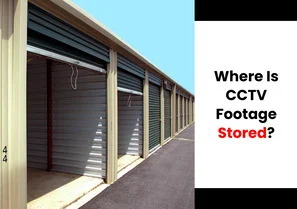CCTV footage is stored in various ways, from on-site storage solutions like NVRs and DVRs to cloud-based platforms. In this blog, we’ll explore the different methods and their benefits, helping you understand where your surveillance data is kept and why it matters.

Where Is CCTV Footage Stored? Different Storage Methods
As the world of surveillance and security continues to evolve, Closed-Circuit Television (CCTV) cameras have become indispensable in monitoring and recording activities. However, have you ever wondered where all that valuable footage is stored? In this comprehensive guide, we will delve into the hierarchy of CCTV footage storage, exploring various options from on-site solutions to cloud-based storage. By the end of this article, you’ll have a clear understanding of where CCTV footage is stored and the benefits of different storage methods.
1. On-Site Storage: Traditional and Reliable
The most traditional method of storing CCTV footage is through on-site storage. In this setup, cameras are connected to either a Network Video Recorder (NVR) or a Digital Video Recorder (DVR). These devices are responsible for recording and storing the footage locally. Typically, the recordings are stored on hard drives within the NVR/DVR. On-site storage offers immediate access to the footage and has been a reliable option for many years.
However, on-site storage does have its limitations. One major drawback is the storage capacity of the NVR/DVR. Hard drives have a finite amount of space, and once they reach their capacity, the system either stops recording or overwrites the oldest footage. This limitation can be a concern, especially in situations where long-term storage is required. Additionally, on-site storage is vulnerable to physical damage, theft, or tampering, which could result in the loss of valuable footage.
2. Network-Attached Storage (NAS): Scalable and Redundant
To overcome the limitations of on-site storage, some organizations opt for Network-Attached Storage (NAS) solutions. NAS devices are connected to the local network and provide additional storage capacity for CCTV footage. This setup allows for scalability and redundancy, reducing the risk of data loss.
NAS devices can be customized to fit the specific storage needs of an organization. By adding multiple hard drives to the NAS, the storage capacity can be expanded as required. This flexibility ensures that organizations can continue recording footage without worrying about running out of space.
Furthermore, NAS devices can be accessed remotely, making it easier to manage and monitor CCTV footage from different locations. This feature is particularly valuable for organizations with multiple sites or those that require remote access to their surveillance data.

3. Cloud-Based Storage: The Future of CCTV Surveillance
In recent years, cloud-based storage has gained significant popularity in the world of CCTV surveillance. With this method, CCTV footage is uploaded and stored on remote servers managed by a third-party service provider. Cloud storage offers numerous advantages, making it an attractive option for many organizations.
- Unlimited Scalability and Accessibility
One of the key benefits of cloud-based storage is its unlimited scalability. Unlike on-site storage or NAS solutions, cloud storage allows organizations to store an almost infinite amount of footage. This scalability is particularly beneficial for organizations with high-volume surveillance requirements or those that need to retain footage for extended periods.
Cloud-based storage also provides accessibility from anywhere with an internet connection. This means that authorized individuals can access the CCTV footage remotely, whether they are in the office, at home, or on the go. This level of flexibility is invaluable, especially for organizations with distributed teams or multiple locations. - Robust Security Measures
Security is a top priority when it comes to storing CCTV footage, and cloud-based storage offers robust security measures. Reputable service providers implement stringent security protocols to protect the data stored on their servers. These measures include advanced encryption, secure data centers, and regular backups to ensure the integrity and confidentiality of the footage.
Cloud storage also eliminates the need for on-site hardware maintenance. Organizations no longer need to worry about managing and updating their storage infrastructure, as it is all handled by the service provider. This not only saves time and resources but also reduces the risk of data loss due to on-site incidents such as hardware failures or natural disasters.
4. Hybrid Solutions: The Best of Both Worlds
While on-site storage, NAS, and cloud-based storage each have their own advantages, many organizations opt for hybrid solutions that combine different methods. This approach provides the best of both worlds – local storage for immediate access and cloud storage for redundancy and remote access.
In a hybrid setup, CCTV footage is simultaneously stored on local hardware and uploaded to the cloud. This redundancy ensures that even if the on-site storage experiences issues, such as hardware failures or power outages, the footage remains accessible through the cloud.
Hybrid solutions offer organizations the flexibility to tailor their storage strategy to their specific needs. For instance, they can choose to retain a certain amount of footage locally for quick retrieval and store the rest in the cloud for long-term storage and remote access.

Conclusion
The storage of CCTV footage is a critical aspect of surveillance and security. Depending on an organization’s needs and preferences, there are various storage options available, including on-site storage, NAS, cloud-based solutions, or a combination of these.
On-site storage provides immediate access to footage but has limitations in terms of capacity and vulnerability to physical damage. NAS solutions offer scalability and redundancy, mitigating the risk of data loss. Cloud-based storage provides unlimited scalability, accessibility from anywhere, and robust security measures. Hybrid solutions combine the benefits of local storage and cloud storage for enhanced accessibility and redundancy.
As technology continues to advance, we can expect even more innovative storage solutions to emerge in the world of CCTV surveillance. Whatever storage method an organization chooses, the ultimate goal is to ensure the security and accessibility of valuable surveillance footage.
Remember, the storage method you choose for your CCTV footage should align with your organization’s specific needs, taking into account factors such as storage capacity, scalability, security, and accessibility. By understanding the different storage options available, you can make an informed decision that best suits your surveillance requirements.









